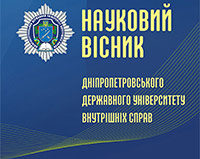Nataliia OBUSHENKO
OBUSHENKO N. (2022), INCORPORATION AS THE MAIN WAY OF SYSTEMATIZATION OF LABOR LEGISLATION: GENERAL CHARACTERISTICS, Scientific Bulletin of Dnipropetrovsk State University of Internal Affairs, Special Issue № 1, 99-104
DOI: 10.31733/2078-3566-2022-5-99-104
ABSTRACT. The article reveals the main way of systematizing incorporation. Incorporation can be carried out on a permanent basis to maintain labor legislation in a proper state, while it makes no sense to carry out codification systematically and constantly, because in order to carry out such an activity, relations in the labor industry must be more or less established, that is, codification is carried out periodically to directly update the legislation.
The subject of the influence of incorporation is normative legal acts in the sphere of labor, in contrast to this, codification is aimed at legal norms, prescriptions and legal institutions. The external form of the result of incorporation of labor legislation is embodied in collections or codes of laws, and codification is usually in codes, foundations, etc., as a rule, incorporation is carried out to provide interested persons with the texts of normative legal acts that have been subject to incorporation, i.e. a certain category of persons, and codification covers all persons entering into labor relations, and as a result, everyone is interested in it. Incorporation is a separate way of systematizing labor legislation, the use of which is important for its further codification.
The article highlights that the incorporation of current legislation is expressed in the full or partial unification in alphabetical, chronological, system-subject order of normative legal acts of a certain level in various collections, with the aim of providing interested persons with the texts of relevant normative acts with all their official changes and additions Incorporation is a form of processing of regulatory material, the purpose of which is only its external arrangement (correction of typographical, grammatical and syntactic errors, exclusion of normative legal acts or parts that have been formally canceled; omission of preambles, signatures of officials, etc.). The result of incorporation is the placement of legal material in different collections in a certain order.
Keywords: systematization of labor legislation, incorporation, regulatory legal acts, labor standards, through external processing and unification of normative material, enter into labor relations, improvement of current legislation, incorporation can be official, unofficial and unofficial, external systematization of legislation, collection of legislation.
References
- Zaychuk O. V., Onishchenko N. M. Teoriya derzhavy i prava [Theory of the state and law]. Academic course: textbook / edited by O. V. Zaychuk, N. M. Onishchenko. Kyiv : Yurinkom Inter. 2006. 688 p. [in Ukr.].
- Kyrychenko V. M. Teoriya derzhavy i prava [Theory of state and law: modular course]: textbook manual. Kyiv : Center for Educational Literature. 2010. 264 p. [in Ukr.].
- Skakun O. F. Teoriya prava i derzhavy [Theory of the law and state] : textbook. 2nd ed. Kyiv : Alerta ; KNT ; CEL. 2010. 520 p. [in Ukr.].
- Teoriya derzhavy i prava : pidruchnyk [Theory of the state and law: textbook] / O. M. Bandurka, O. M. Golovko, O. S. Perederii and others. ; general ed. by O. M. Bandurka. Ministry of Internal Affairs of Ukraine, Kharkiv national University of Internal Affairs. Kharkiv, 2018. 416 p. [in Ukr.].
- Zahal’na teoriya derzhavy i prava [The general theory of the state and law] : pidruch. dlya stud. yuryd. spets. / M. V. Tsvik, V. D. Tkachenko, L. L. Bogachova and others; edited by M. V. Tsvika, V. D. Tkachenko, O. V. Petryshyn. Kharkiv: Pravo. 2002. 432 p. [in Ukr.].
